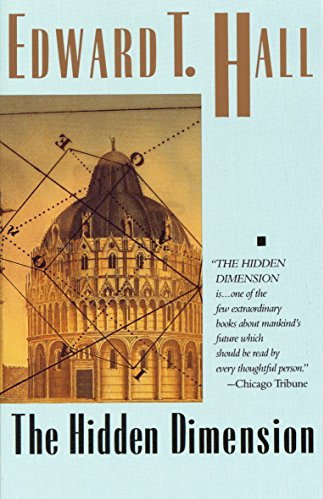What do you think?
Rate this book


256 pages, Paperback
First published January 1, 1966

“Man… is distinguished from other animals by virtue of the fact that he has elaborated extensions of his organism by developing his extensions. Man has been able to improve her specialized various functions. The computer is an extension of the brain. The telephone extends the voice. The wheel extends the leg and feet. Language extends experience in time and space while writing extends language. Man has shifted evolution from his body to his extensions and in doing so has tremendously accelerated the evolutionary process… It may be profitable in the long run if Man is viewed as an organism that has elaborated and specialized his extensions to such a degree that they have taken over and are rapidly replacing nature. In other words, man has created a new dimension, the cultural dimension of which proxemics is only a part."His discussion of varying levels of perception evolving to convey increasingly more information over time was truly mind-blowing. Like how a baby primarily gathers information through touch, until it can make sense of other stimuli. Even viewing sensory perception as organizations of data is pretty cool when you focus on one being reinforced, altered, or in conversation with others. The chapter on Vision as Synthesis was extremely profound, distinguishing between the retinal image and what man perceives– the difference between the visual field and visual world, “The visual field is made up of constantly shifting light patterns recorded by the retina which man uses to construct his visual world”.
“We can never be aware of the world as such, but only of the impingement of physical forces on sensory receptors- F.P. Kilpatrick, Explorations In Transactional Psychology.
“By studying man's artistic productions, it is possible to learn a great deal about the sensory world of the past and how man's perception changes, as does the nature of his awareness of perception.”“Why was it that the Greek sculpture was a full thousand years ahead of Greek painting?”Overall, I would have loved more examples of visual art reflecting historical conceptions of spatiality, and considering there were several sequences with photos in this book, I would have loved to see some of them printed here for a more comprehensive gallery of examples.
“The world is presented in a kaleidoscopic flux of impressions which has to be organized by our minds- and this means largely by the linguistic systems in our minds. We cut nature up, organize it into concepts, and describe significances as we do largely because we are parties to an agreement to organize it in this way- an agreement that holds throughout our speech community and is codified and the patterns of our language”,it's easy to see why his studies on the unconventional conceptions of space and time in the Hopi language are extremely relevant to see the metaphysical implications of language and its limitations.
How long can man afford to consciously ignore his own dimension?...
Such research is no more a luxury than the gauges in an airplane cockpit.